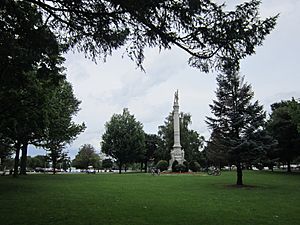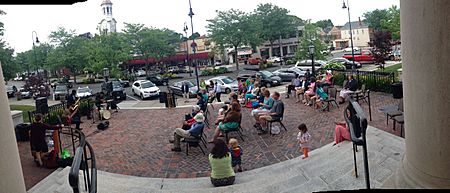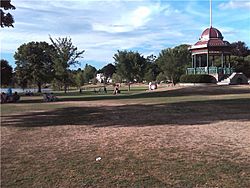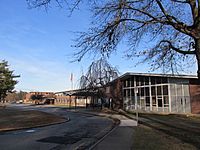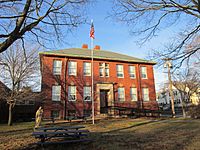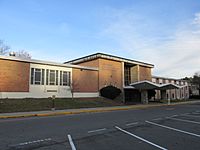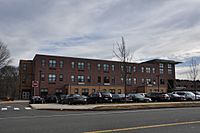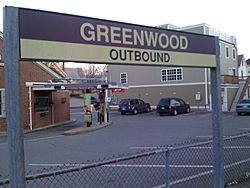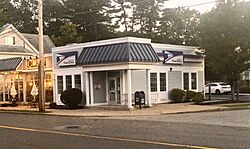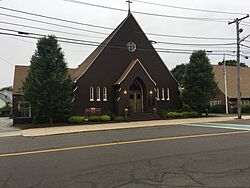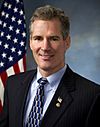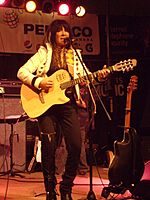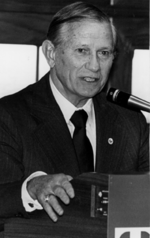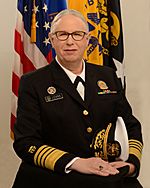Wakefield, Massachusetts facts for kids
Quick facts for kids
Wakefield, Massachusetts
|
||
|---|---|---|
|
Each row, from left to right:
Softball at Veterans Field Wakefield Common, Park Avenue, Saint Joseph School, Upper Depot, Col. James Hartshorne House, Elizabeth Boit House, Lake Quannapowitt, 1 Morrison Avenue, Lower Common Bandstand in Winter, Greenwood Union (now Restoration Road) Church |
||
|
||
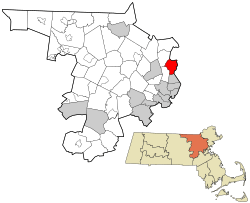
Location in Middlesex County in Massachusetts
|
||
| Country | ||
| State | ||
| County | Middlesex | |
| Region | New England | |
| Settled | 1638 | |
| Incorporated | 1812 | |
| Renamed "Wakefield" | 1868 | |
| Named for | Cyrus Wakefield | |
| Government | ||
| • Type | Open town meeting | |
| Area | ||
| • Total | 20.5 km2 (7.9 sq mi) | |
| • Land | 19.3 km2 (7.5 sq mi) | |
| • Water | 1.1 km2 (0.4 sq mi) | |
| Elevation | 30 m (100 ft) | |
| Population
(2020)
|
||
| • Total | 27,090 | |
| • Density | 1,321/km2 (3,429/sq mi) | |
| • Demonym | Wakefieldian | |
| Time zone | UTC-5 (Eastern) | |
| • Summer (DST) | UTC-4 (Eastern) | |
| ZIP code |
01880
|
|
| Area code(s) | 339 / 781 | |
| FIPS code | 25-72215 | |
| GNIS feature ID | 0619410 | |
| Website | http://www.wakefield .ma.us/ |
|
Wakefield is a town in Middlesex County, Massachusetts, in the greater Boston area. It was officially formed in 1812. The town is about 12.5 miles (20 km) north-northwest of Downtown Boston. In 2020, Wakefield had a population of 27,090 people. The town is well-known for activities around its local lake, Lake Quannapowitt.
Contents
- History of Wakefield
- Geography of Wakefield
- Climate and Weather
- People of Wakefield
- Education in Wakefield
- Neighborhoods of Wakefield
- Places to Visit in Wakefield
- Transportation in Wakefield
- Media in Wakefield
- Sports in Wakefield
- Annual Events in Wakefield
- Images for kids
- Famous People from Wakefield
- See also
History of Wakefield
Wakefield was first settled in 1638. It was originally called Lynn Village. In 1644, it officially separated from Lynn and became the town of Reading. This is when the first church and first mill were built. The first mill was a corn mill on the Mill River. Later, small sawmills were built on the Mill River and the Saugus River.
Thomas Parker (1609–1683) was one of the people who helped start Reading. His home was in what is now downtown Wakefield. He also helped found the first church and served as a deacon. Parker was important in naming the town, possibly after land called Ryddinge in England.
How Wakefield Got Its Name
Over time, the original parish church became known as the Old or South Parish. In 1713, a North Parish was created, which later became North Reading. In 1812, the Old or South Parish separated from Reading and was named South Reading.
The railroad came to the area in 1844, connecting Wilmington to Boston. This helped industries grow. The Boston Ice Company began cutting and shipping ice from Lake Quannapowitt in 1851.
A big change happened in 1856 when Cyrus Wakefield started the Rattan Works, which made wicker furniture. This company grew very large, employing a thousand people at one point. In 1868, Cyrus Wakefield gave land and money for a new town hall. To show their thanks, the town voted to change its name from South Reading to Wakefield.
Important Buildings and Businesses
The South Reading Public Library was started in 1856. It later became the Beebe Town Library. In 1923, the Lucius Beebe Memorial Library was built by Junius Beebe, whose father was Lucius Beebe.
One of the oldest and largest makers of flying model airplane toys in the world, Paul K. Guillow, Inc., is located in Wakefield. They are famous for their balsa wood model airplane kits.
Route 128 was built near the town in 1958. A large insurance company, American Mutual, built its headquarters there. Later, the building was bought by Comverse, a company that made voice mail systems.
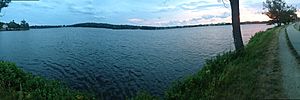
In the northeastern part of Wakefield, there was once an amusement park called Pleasure Island. It was called "The Disneyland of the Northeast." However, it closed in 1969 after only ten years. A fire destroyed much of it in 1971. Now, this area has office buildings and is called "Edgewater Park."
In 2012, Wakefield celebrated 200 years since it became a town. In 2018, it celebrated 150 years since its name changed to Wakefield.
Recent Events: Interstate 95 Incident
On July 3, 2021, a group called "Rise of the Moors" was stopped by police on I-95 in Wakefield. This led to a standoff that blocked traffic. All eleven people involved were safely taken into custody, ending the incident.
Geography of Wakefield
 |
 |
|||
Wakefield |
||||

|

|

|
Wakefield is located at 42°30′4″N 71°4′16″W / 42.50111°N 71.07111°W. It is bordered by several other towns: Reading to the northwest, Melrose to the south, Stoneham to the southwest, Lynnfield to the northeast, and Saugus to the southeast. The borders with Lynnfield and Saugus are also the county line between Middlesex and Essex County.
The center of Wakefield, known as Wakefield Lower Common, is about 10.3 miles (16.6 km) north of Government Center, Boston.
Route 129 runs through Wakefield as its Main Street. I-95/Route 128 runs along the northwestern edge of Wakefield.
The town covers a total area of 7.9 square miles (20.5 km²). About 7.5 square miles (19.3 km²) is land, and 0.4 square miles (1.1 km²) is water.
Lakes and Waterways
Wakefield has two main lakes: Crystal Lake and Lake Quannapowitt. Crystal Lake is used for the town's drinking water, so activities like swimming or boating are not allowed there.
Lake Quannapowitt, on the other hand, is very popular for recreation. People enjoy boating, windsurfing, kayaking, and fishing on the lake. It is also the main source of the Saugus River.
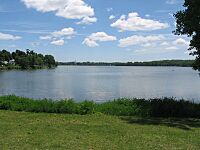
In 1847, Lake Quannapowitt was named after James Quannapowitt, a Native American who signed an important deed in 1686. Before that, settlers simply called it the "Greate Pond."
The Quannapowitt Yacht Club, founded in 1886, is the oldest inland yacht club in the United States. Lake Quannapowitt is considered "Wakefield's greatest natural resource." It covers about 247 acres (1 km²). The Wakefield Common is next to the lake and hosts many events. A group called "The Friends of Lake Quannapowitt" works to protect the lake and teach people about it.
Wakefield has been recognized as a Arbor Day Foundation Tree City USA every year since 2001.
Climate and Weather
Wakefield has a typical Northeastern United States climate. Winters are cold and snowy, springs are cool and rainy, autumns are cool and sunny, and summers are hot and humid. Sometimes, droughts happen in the summer, causing lake levels to drop.
Major Storms in Wakefield
Wakefield has experienced some big snowstorms. In January 2011, the town received 2 to 3 feet (0.6 to 0.9 meters) of snow during a Nor'Easter. In February 2013, during Winter Storm Nemo, Wakefield got 27.5 inches (0.7 meters) of snow. In January 2015, Winter Storm Juno brought an unofficial 29 inches (0.74 meters) of snow.
In 2020, Wakefield was hit by two significant storms. On August 24, a severe thunderstorm with a microburst caused downed power lines, broken trees, and a house fire. Damage was especially heavy in the Greenwood area. Then, on October 30, an unusual October snowstorm, nicknamed "Snowtober," brought record snowfall for the month.
| Climate data for Wakefield, Massachusetts | |||||||||||||
|---|---|---|---|---|---|---|---|---|---|---|---|---|---|
| Month | Jan | Feb | Mar | Apr | May | Jun | Jul | Aug | Sep | Oct | Nov | Dec | Year |
| Mean daily maximum °F (°C) | 35 (2) |
38 (3) |
46 (8) |
56 (13) |
67 (19) |
77 (25) |
82 (28) |
80 (27) |
73 (23) |
62 (17) |
51 (11) |
40 (4) |
59 (15) |
| Mean daily minimum °F (°C) | 15 (−9) |
18 (−8) |
26 (−3) |
35 (2) |
45 (7) |
54 (12) |
60 (16) |
59 (15) |
50 (10) |
39 (4) |
31 (−1) |
21 (−6) |
38 (3) |
| Average precipitation inches (mm) | 4.36 (111) |
3.57 (91) |
4.37 (111) |
4.17 (106) |
3.85 (98) |
3.64 (92) |
3.66 (93) |
3.50 (89) |
3.82 (97) |
4.47 (114) |
4.64 (118) |
4.36 (111) |
48.31 (1,227) |
| Source: Wakefield Weather – Wakefield, MA - Weather Data – Normal Temperatures and Normal Precipitation at IDcide | |||||||||||||
People of Wakefield
| Historic populations for Wakefield, Massachusetts, 1850—present | ||
|---|---|---|
| Year | Pop. | ±% |
| 1850 | 2,407 | — |
| 1860 | 3,207 | +33.2% |
| 1870 | 4,135 | +28.9% |
| 1880 | 5,547 | +34.1% |
| 1890 | 6,982 | +25.9% |
| 1900 | 9,290 | +33.1% |
| 1910 | 11,404 | +22.8% |
| 1920 | 13,025 | +14.2% |
| 1930 | 16,318 | +25.3% |
| 1940 | 16,223 | −0.6% |
| 1950 | 19,633 | +21.0% |
| 1960 | 24,295 | +23.7% |
| 1970 | 25,402 | +4.6% |
| 1980 | 24,895 | −2.0% |
| 1990 | 24,825 | −0.3% |
| 2000 | 24,804 | −0.1% |
| 2010 | 24,932 | +0.5% |
| 2020 | 27,090 | +8.7% |
| 2023* | 27,810 | +2.7% |
| * = population estimate. Source: United States Census records and Population Estimates Program data. | ||
In 2010, Wakefield had 24,932 people living in 9,994 households. The average household had about 2.47 people.
Diversity in Wakefield
In 2010, most of Wakefield's population (94.5%) was White. Other groups included Asian (2.6%), Black or African American (0.9%), and Native American (0.1%). About 2.3% of the population was Hispanic or Latino.
The median age in Wakefield in 2010 was 41.9 years old.
Ancestry and Cost of Living
In 2007–2008, the main ancestries in Wakefield were Irish (33%), Italian (28.5%), and English (13.4%).
The cost of living in Wakefield is higher than the U.S. average. In 2008, the median household income was $85,011, which was about $20,000 more than the average for Massachusetts.
Education in Wakefield
Wakefield has two high schools: Wakefield High School (a public school) and Northeast Vocational (a regional vocational school). The town also has one middle school, Galvin Middle School, and four elementary schools: Greenwood, Walton, Woodville, and Dolbeare. Doyle School is the town's public preschool.
The Little Red School House, also known as the West Ward School, was a one-room schoolhouse. It is now preserved and houses the Wakefield Historical Society.
Wakefield School Committee
The Wakefield School Committee manages the Wakefield Public Schools. The superintendent is Doug Lyons. The School Committee is made up of elected members who control most of the town's spending on schools.
Neighborhoods of Wakefield
Wakefield is divided into several neighborhoods:
- Greenwood covers most of Southern Wakefield. It borders Melrose and Saugus. Greenwood even has its own satellite U.S. Post Office.
- Woodville is in the central-eastern part of Wakefield.
- The Downtown/Wakefield Square area stretches from Crystal Lake to Lake Quannapowitt.
- The West Side includes almost all of Wakefield that is west of Lake Quannapowitt and Crystal Lake.
- The East Side is actually closer to the geographical center of town, near Crystal Lake.
- Lakeside is in northern-central Wakefield, along the eastern shore of Lake Quannapowitt. It borders Reading.
- Montrose is in northeastern Wakefield, bordering Lynnfield. Many of Wakefield's smaller ponds are in this area.
Places to Visit in Wakefield
- Lake Quannapowitt is a great place for walking, jogging, biking, and rollerblading.
- The Lucius Beebe Memorial Library is a beautiful building and a town resource.
- The town common is Wakefield's central park. It's on the southern edge of Lake Quannapowitt. Many events happen here, like summer concerts and Fourth of July celebrations.
- Breakheart Reservation, located in Saugus, is also easy to reach from Wakefield and offers outdoor activities.
- The Wakefield History Museum is on Prospect Street.
Places of Worship
Wakefield has many places of worship for different faiths:
- First Parish Congregational Church (Downtown)
- Emmanuel Episcopal Church (Downtown)
- Most Blessed Sacrament Church (Greenwood)
- Restoration Road Church (Greenwood)
- Romanian Orthodox Church (East Side)
- St. Florence Parish (Montrose)
- St. Joseph Parish (West Side)
- Temple Emmanuel (West Side)
- Wakefield–Lynnfield United Methodist Church (Montrose)
- Christ the King North Shore (Wakefield Junction)
- Mun Su Sa Buddhist Temple (Montrose)
First Baptist Church Fire
The First Baptist Church of Wakefield was built in 1872. On October 23, 2018, it was destroyed by a lightning strike and fire. Firefighters worked all night to put out the blaze. The church has since been rebuilt and officially reopened on September 8, 2024.
Transportation in Wakefield
Wakefield has an MBTA Commuter Rail station in the center of town on the Haverhill/Reading Line. There's also a second station in the Greenwood section. A former Boston and Maine Railroad station is now on the National Register of Historic Places.
Several MBTA buses on Route 137 connect Wakefield to nearby communities. These include the Oak Grove and Malden Center rapid transit stations on the Orange Line.
Rt. 128/I-95 runs through Wakefield with several exits. State Route 129 also passes through the town. Nearby, US Route 1 runs through Saugus and Lynnfield, and I-93 runs through Stoneham.
Media in Wakefield
Wakefield has two daily newspapers: the local Daily Item and an edition of the Daily Times Chronicle. There is also a weekly paper, the Wakefield Observer. Students at Wakefield Memorial High School write their own newspaper, "WHS exPRESS". The town also has a public access cable channel called WCAT Wakefield.
Sports in Wakefield
Wakefield has many sports fans and a strong youth sports culture. Wakefield High School has popular teams in football, baseball, softball, hockey, and basketball. The football team won Division II "Super Bowl" titles in 1999 and Division III in 2022, completing an undefeated season. The men's and women's basketball teams won Division II state championships in 1997.
Baseball is a popular sport in spring and summer. There are two men's semiprofessional teams: the Wakefield Merchants and a team representing the local American Legion.
Young athletes in Wakefield can play many different sports. These include baseball, basketball, lacrosse, football, soccer, hockey, dance, cheerleading, and softball.
Annual Events in Wakefield
Wakefield hosts several fun events throughout the year:
- Town Day
- Festival By The Lake (second Saturday in June)
- Independence Day Parade / Home Town March (July 4)
- Concerts on the Common / Wakefield Summer Band Concert Series (July–September)
- Festival Italia (usually third Saturday in August)
- Wakefield Porchfest (early September) – a new music festival started in 2024 with many musical acts performing across the town.
- Homecoming Celebration in Autumn
- Tis the Season Holiday Stroll (first Saturday in December)
Images for kids
Famous People from Wakefield
- Russell Banks (1940–2023), an author, spent part of his childhood in Wakefield.
- Lucius Morris Beebe (1902–1966), an author and journalist, was born in Wakefield.
- Elizabeth Boit, a textile manufacturer.

- William Brewster (1851–1919), an ornithologist (someone who studies birds), was born in Wakefield.
- Bruce Brown, an NBA basketball player, played at Wakefield High School. He won an NBA championship with the Denver Nuggets in 2023.
- Scott Brown, a former U.S. Senator from Massachusetts.
- Joe Cannata, a professional ice hockey goalie.
- Rich Ceisler (1956–2014), a comedian and author.
- Carleton S. Coon, an anthropologist.
- David Dellinger, a pacifist activist, was born in Wakefield.
- Anthony Fabiano, a retired NFL player for the Cleveland Browns.
- Ernie Gahan (1926–2009), a stock car racing driver.
- John Galvin, a U.S. Army general and former NATO Supreme Allied Commander. Wakefield's middle school is named after him.
- Kayla Harrison, a judoka (judo athlete) and two-time Olympic gold medalist. She was the first American to win an Olympic medal in judo.
- Israel Horovitz (1939–2020), a playwright and screenwriter born in Wakefield.
- Mark Kumpel, a member of the 1984 U.S. Olympic ice hockey team and former NHL player.
- Dave Lapham, a former NFL player and current radio broadcaster.
- Rachel Levine, a pediatrician and the current Assistant Secretary for Health in the U.S. government. She grew up in Wakefield.
- John Lilley, a member of the 1994 U.S. Olympic ice hockey team and former NHL player.
- Buffy (Beverly) Sainte Marie, a folksinger and composer, was raised in Wakefield.
- James Massone, a former contestant on the TV show The Voice.
- A. David Mazzone (1928–2004), a U.S. District Court Judge known for ordering the cleanup of Boston Harbor. He lived in Wakefield.
- Charlie Moore, host of NESN's Charlie Moore Outdoors.
- Marcia Pankratz, a member of the 1988 and 1996 Olympic field hockey teams.
- Jimmy Pedro, an Olympic medalist in judo and former world champion.
- Charles Lenox Remond, an activist and abolitionist, lived in Wakefield.
- C. F. Russell (1897–1987), an American occultist and writer.
- Louis Sullivan, an architect considered a father of modernism, lived in Wakefield during his school years.
- Richard Tisei, a former Massachusetts State Senate Minority Leader.
- Ernest Tyzzer (1875–1965), a pathologist.
- John Anthony Volpe (1908–1994), a three-time Republican governor of Massachusetts, U.S. Secretary of Transportation, and Ambassador to Italy. He was born in Wakefield.
- Burrage Yale (1781–1860), a tin ware manufacturer and a major employer in early 19th-century Wakefield.
See also
 In Spanish: Wakefield (Massachusetts) para niños
In Spanish: Wakefield (Massachusetts) para niños














